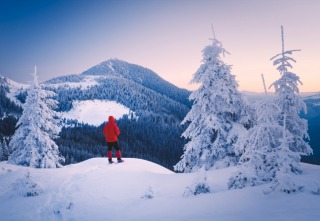 While some people use the winter as an excuse to burrow into their blankets and do as little physical activity outdoors as possible, that’s a huge mistake. Wintertime is an excellent time to get outside. Don’t hurry from warm interior environment to warm interior environment, trying to minimize exposure. Dally outdoors. Feel the chill. Experience the elements. Embrace the cold.
While some people use the winter as an excuse to burrow into their blankets and do as little physical activity outdoors as possible, that’s a huge mistake. Wintertime is an excellent time to get outside. Don’t hurry from warm interior environment to warm interior environment, trying to minimize exposure. Dally outdoors. Feel the chill. Experience the elements. Embrace the cold.
How to Embrace the Cold
To embrace the cold, you must understand that cold is just a feeling. To go outside in cold weather, the promise of heat and warmth and soft blankets in the house behind you—this is true luxury. The cold poses no threat to your safety and security, only to your momentary comfort. And so you must go forth boldly into the cold. As the cold air hits your skin, you are losing body heat in an eternal exchange between you and your environment, but this is okay. It’s uncomfortable, yes, but it’s not going to hurt you. You must understand this.
You must understand that cold exposure will increase the activation of brown fat, a metabolically active type of adipose tissue that burns energy to keep you warm, thereby improving metabolic health. Understand that in order to grow, in order to benefit from any training modality, you must first feel discomfort. This is a law of nature that cannot be avoided. You must first feel the discomfort and then recover from it. When you are exposed to cold your body is learning to adapt to it; cold exposure is a training session just like lifting weights or running sprints. Think of it as a beneficial part of the process, and it won’t feel so bad.
Best of all, feeling the cold makes you appreciate the warmth.
There’s nothing better than a hot bath after a two-hour hike through the snow.
There’s nothing better than a warm bed after a long day working outside in the cold.
There’s nothing better than a hot meal after a training session in the cold garage.
You need to experience both extremes to appreciate them.
Ways to Embrace the Cold
Okay, so how do you do it?
Go for a daily walk with as little clothing as possible.
Ideally you do it shirtless or in a T-shirt and shorts. You can even go barefoot. After all, remember what I said before: you are in no danger of dying from exposure. You can always return to a warm place. You will be fine. Keep that in mind and get walking.
Plus, as long as you’re moving, you won’t really get that cold. That’s the secret of cold exposure. Movement staves off subjective cold.
Exercise in the cold.
If it’s not directly outside, you can do it in an unheated garage. Start out with warm clothing on because, after all, you do want to raise your body temperature before you perform any intense movements.
Keep the warm clothing on as the workout proceeds, if you must, but the point is is to exercise outside in the cold. What this does is send a message to your nervous system that you can handle the stress of physical activity and exertion in cold weather. It can be a powerful stimulus to expend more energy, which is often one of our weak points in the colder months.
Go snowshoeing as much as possible.
For my money it is one of the best ways to traverse the snowy expanse. I haven’t done it much since I was a kid living in Maine. Back then, it was often the best way to get around, to explore during winter. We kids had a ton of freedom, rain or snow or shine. When the snow was feet deep and we weren’t content to sit around and play the video games and electronic devices that had yet to be invented, we had to snowshoe if we wanted to exercise that freedom.
I can’t do it much these days. Miami doesn’t get much snow, and snowshoeing doesn’t really work in sand. When I do hit the snow, I’m snowboarding. But man, snowshoeing is fantastic fun. You can climb and descend steep slopes. You actually have better traction than on normal ground. You can head off in between the trees, going where the normally-shod don’t dare to go, and really get around.
I wish I had to opportunity to snowshoe during winter whenever I wanted. If you do, take advantage. Go where it’s quiet and empty, the only sound you hear the satisfying crunch of the snowshoe touching down and digging in. There’s nothing like coming upon a babbling brook half frozen over, walking to the edge, confident you’ll be fine because you’re snow-shod.
It forces you into a different pattern of movement. You’re not quite as agile as you are in normal shoes. You have to think about what you’re doing and where you’re going. You have to be deliberate.
Get plenty of sunlight.
The sunlight still matters. You may not be making much vitamin D from the paltry UVB available but you will be getting bright natural sunlight into your eyes and on your skin. This has powerful effects on your circadian rhythm, improving your sleep and subsequent resistance to the harmful effects of blue light after dark. The sun still matters even though it’s cold. It arguably matters even more because it’s more scarce than during spring and summer.
Grab all you can.
Get into the cold ocean.
I used to hate swimming in cold water, but now I love it. I find it bracing, to be honest. It’s far from comfortable, mind you.
The best way to do it, I’ve found, is the following:
Run some beach sprints. Not much has changed from 2007. You run the beach sprints at low tide, when the sand is nice and flat and slightly damp. This isn’t just your workout for the day. It gets you hot and sweaty, and it gets your body temperature up so you not only can handle the cold, you crave the cold. Note: if you’ve already trained that day, don’t push yourself too hard. Run a couple sprints instead of a full workout or even just take a brisk walk, throw the frisbee around, wrestle with the kids, run the dog. You get the picture. Just move and get the blood pumping.
Go right in the water. Don’t think about it. Don’t slowly introduce body parts. Just go for it. Get your head underwater ASAP. The real cold shock hits when your head goes underwater. That’s when mild panic can set in. That’s when your nervous system truly wakes up. It’s also what forces the quickest adaptation to the temperature for the rest of your body. If your head and its precious cargo can withstand the cold, the rest of your body will have no issues.
Rub yourself down with the cold water. Rub it into your hair. Get some sand in your hand and rub your body down. Scrub it. For my money, there’s no better hair than post-beach swim hair. Does something magical to your hair and skin.
Stay out there as long as you can. Be safe, obviously, but try to go longer than a quick dip and dash. An unheated pool or cold plunge will also do the trick, but there’s nothing quite like the cold ocean.
Hot tub in the cold.
One of my favorite snow-time activities is to get in the hot tub. You get that hot cold contrast that makes life worth living. You can even do snow plunges and then get back in the warm water.
Obviously, you need a hot tub for this to work, but if you can swing it, it’s outstanding.
Engage in snow sports.
I’m a big snowboarder personally—it just feels better on my knees—but any of the classic snow sports are admirable and effective ways to embrace the cold: skiing, cross-country skiing, ice biking, mountaineering, ice skating. The point is to get outside in the cold and engage in activities you can only do in the snow.
When I snowboard, I’m not all bundled up. I keep my limbs as exposed to the air as I can. Maybe I’ll just wear a waterproof top layer to avoid getting wet. I want to feel the wind chill as I rush down the mountain, and I want to get my internal engine going so hot that it extinguishes the cold.
Those are my suggestions for embracing the cold. The most important thing is the first point I mentioned: understand that the cold isn’t going to kill you and will only make you stronger, healthier, and more appreciative of the warmth and life in general.
How do you prefer to embrace the cold?
The post Embracing the Cold appeared first on Mark's Daily Apple.






